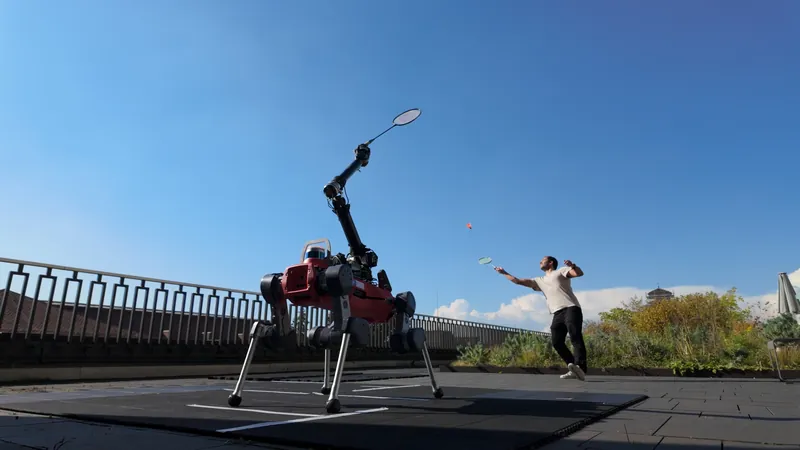
Meet ANYmal: The AI-Powered Robot Dog Dominating the Badminton Court!
2025-09-03
Author: Yu
A Game-Changer in Robotics
In an exciting leap for robotics, scientists have successfully trained a four-legged robot, affectionately known as ANYmal, to engage in badminton matches against human opponents. This agile automaton can seamlessly navigate the court, executing rallies of up to 10 shots with impressive skill.
Brain Meets Brawn: AI Takes the Lead
Equipped with cutting-edge artificial intelligence, ANYmal has mastered visual perception and whole-body movement, allowing it to strategically reach the shuttlecock and return it over the net. As detailed in a groundbreaking study published in the journal Science Robotics, the research demonstrates that quadrupedal robots can now take on complex sports tasks.
The Power of Four Legs
ANYmal isn't just a pretty face. Weighing in at 110 pounds and standing at 1.5 feet tall, its four-legged design enables it to conquer various terrains and obstacles. Researchers have previously experimented with adding arms to similar robots for tasks like fetching and opening doors, but mastering the coordination of limbs and visual input in dynamic environments is no small feat.
Innovation in Action: A Badminton Robot Redefined
For this project, researchers enhanced ANYmal by attaching a dynamic arm that holds a badminton racket at a strategic angle. This modification elevated the robot's height to 5 feet 3 inches and endowed it with 18 joints—three on each leg and six on the arm. A sophisticated control system governs its movements, aided by a stereo camera that processes real-time visual data on incoming shuttlecocks.
The Learning Curve: Reinforcement Learning at Its Finest
ANYmal's badminton skills were honed through a method known as reinforcement learning. In a simulated training environment, the robot learned to track virtual shuttlecocks and gauge their trajectories. It faced rigorous training protocols, receiving rewards for precision and timing in its swings, with a focus on efficiency in movement throughout the court.
From Simulation to Reality: A Bold New Player
After an impressive 50 million simulation trials, the knowledge gained was transferred into the real-world robot. ANYmal was tested with actual shuttlecocks served by another machine, giving it the challenge of quickly and accurately returning shots while adjusting its movement based on distance.
A Fast Learner: Outpacing Human Amateurs
Following extensive training, ANYmal can swing at speeds up to 39 feet per second—about half the speed of an average human amateur player. Remarkably, it even learned to return to the center of the court after each hit, mimicking the instinctual behavior of human athletes.
Next Steps: Enhancing Robot Intelligence
However, the researchers noted a vital area for improvement: ANYmal currently does not take into account environmental factors, such as an opponent’s position, which is key for predicting shuttlecock trajectories. Future advancements could include adding a neck joint for better visual tracking, enhancing its gameplay.
Looking Beyond Sports: Future Applications
Beyond the badminton court, this research could have far-reaching implications. As Yuntao Ma, a key researcher, suggested, the technology could be adapted for crucial roles in disaster relief, where agile movement and dynamic visual perception are essential.
A New Era of Athletic Robots
The development of ANYmal marks a significant chapter in the integration of AI with robotics, showcasing how far we’ve come in creating machines capable of participating in and excelling at human sports. Keep an eye on this innovative robot—it's not just learning to play; it’s redefining the game!



 Brasil (PT)
Brasil (PT)
 Canada (EN)
Canada (EN)
 Chile (ES)
Chile (ES)
 Česko (CS)
Česko (CS)
 대한민국 (KO)
대한민국 (KO)
 España (ES)
España (ES)
 France (FR)
France (FR)
 Hong Kong (EN)
Hong Kong (EN)
 Italia (IT)
Italia (IT)
 日本 (JA)
日本 (JA)
 Magyarország (HU)
Magyarország (HU)
 Norge (NO)
Norge (NO)
 Polska (PL)
Polska (PL)
 Schweiz (DE)
Schweiz (DE)
 Singapore (EN)
Singapore (EN)
 Sverige (SV)
Sverige (SV)
 Suomi (FI)
Suomi (FI)
 Türkiye (TR)
Türkiye (TR)
 الإمارات العربية المتحدة (AR)
الإمارات العربية المتحدة (AR)